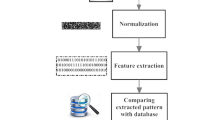Abstract
This paper presents a model in the Artificial Embryogene (AE) framework. The presented system tries to model the main functions of the biological cell model. The main part of this paper describes the Gene Regulatory Network (GRN) model, which has a similar processing information capacity as Boole’s Algebra. This paper also describes how to use it to perform the Iris Classification problem which is a pattern classification problem. The aim of this work is to show that the model can solve this kind of problems.
Access this chapter
Tax calculation will be finalised at checkout
Purchases are for personal use only
Preview
Unable to display preview. Download preview PDF.
Similar content being viewed by others
References
Stanley, K., Miikkulainen, R.: A Taxonomy for Artificial Embryogeny. In: Proceedings of Artificial Life 9, pp. 93–130. MIT Press, Cambridge (2003)
Lindenmayer, A.: Mathematical models for cellular interaction in development: Part I and II. Journal of Theorical Biology 18, 280-299, 300–315 (1968)
Turing, A.: The chemical basis of morphogenesis. Philosofical Transactions of the Royal Society B 237, 37–72 (1952)
Kitano, H.: Designing neural networks using genetic algorithm with dynamic graph generation system. Complex Systems 4, 461–476 (1990)
Hornby, G.S., Pollack, J.B.: Creating high-level components with a generative representation for body-brain generation. Artificial Life 8(3) (2002)
Kauffman, S.A.: Metabolic stability and epigenesis in randomly constructed genetic nets. Journal of Theoretical Biology 22, 437–467 (1969)
Steiner, T., Jin, Y., Sendhoff, B.: A Cellular Model for the Evolutionary development of Lightweight Material with an Inner Structure. In: Proceedings of Genetic and Evolutionary Computation Conferences 2008, Atlanta, pp. 851–858 (2008)
Kumar, S.: Investigating Computational Models of Development for the Construction of Shape and Form. PhD Thesis. Department of Computer Science, University College London (2004)
Fernandez-Blanco, E., Dorado, J., Rabuñal, J.R., Pedreira, N., Gestal, M.: A Computational Approach to Simple Structure Development. In: Almeida e Costa, F., Rocha, L.M., Costa, E., Harvey, I., Coutinho, A. (eds.) ECAL 2007. LNCS (LNAI), vol. 4648, pp. 825–834. Springer, Heidelberg (2007)
Holland, J.H.: Adaptation in natural and artificial systems. University of Michigan Press, Ann Arbor (1975)
Asuncion, A., Newman, D.J.: UCI Machine Learning Repository. University of California, School of Information and Computer Science, Irvine, CA (2007), http://www.ics.uci.edu/~mlearn/MLRepository.html
Kephart, J.O., Chess, D.M.: The vision of Autonomic Computing. IEEE Computer Society Press, Los Alamitos (2003), 0018-9162. 41-50
Author information
Authors and Affiliations
Editor information
Editors and Affiliations
Rights and permissions
Copyright information
© 2011 Springer-Verlag Berlin Heidelberg
About this paper
Cite this paper
Fernandez-Blanco, E., Dorado, J., Serantes, J.A., Rivero, D., Rabuñal, J.R. (2011). Artificial Cells for Information Processing: Iris Classification. In: Kampis, G., Karsai, I., Szathmáry, E. (eds) Advances in Artificial Life. Darwin Meets von Neumann. ECAL 2009. Lecture Notes in Computer Science(), vol 5777. Springer, Berlin, Heidelberg. https://doi.org/10.1007/978-3-642-21283-3_6
Download citation
DOI: https://doi.org/10.1007/978-3-642-21283-3_6
Publisher Name: Springer, Berlin, Heidelberg
Print ISBN: 978-3-642-21282-6
Online ISBN: 978-3-642-21283-3
eBook Packages: Computer ScienceComputer Science (R0)




